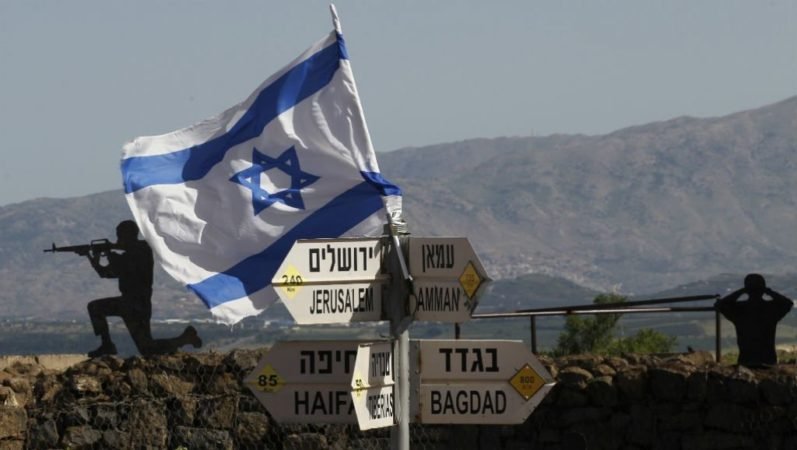Israel on the Golan Heights enhances US interests

While US recognition of Israel’s sovereignty over the Golan Heights bolsters the national security of the Jewish State, it also yields major strategic benefits for the US.
Thus, President Trump’s endorsement of Israeli sovereignty over the strategically commanding Golan Heights – which may be reinforced by a Congressional resolution – highlights the synergy between the national security of the US and Israel. It underlines the mutually-beneficial, two-way-street strategic coordination and cooperation between the US and Israel.
This endorsement enhances the posture of deterrence of Israel – a systematic, unwavering, effective beachhead of the US in the Middle East – and therefore extends the strategic hand of the US, without the need to deploy additional US forces to the region.
In fact, Israel’s upgraded strategic profile has been
For example, in 1970, pro-Soviet Syria invaded pro-US Jordan, aiming to topple the Hashemite regime and trigger an anti-US ripple effect into the Arabian Peninsula and the Persian Gulf. It could have toppled the pro-US oil-producing regimes in Saudi Arabia, Kuwait, the UAE, Bahrein and Oman, granting the USSR a global bonanza, and dealing a major blow to the economy and national security of the US (when the US was heavily dependent upon Persian Gulf oil), during the Vietnam quagmire, which precluded a dispatch of US troops to Jordan.
President Nixon called Israeli Prime Minister Golda Meir, who reinforced Israel’s military presence on the Golan Heights – the joint frontier between Israel, Syria and Jordan – delivering a clear warning to Damascus, which is located 37 miles from the Golan Heights. Israel’s posture of deterrence triggered a swift rollback of the Syrian invasion (within 48 hours), with no exchange of fire between the two military forces.
Thus, in 1970, Israel’s control of the Golan Heights – with no need for US military involvement – minimized regional violence and instability, secured the survival of key pro-US Arab regimes, prevented a major anti-US domino-effect in the Middle East with its drastic financial and military consequences, and spared the globe a potential super-powers confrontation.
In 2019, the control of the Golan Heights enables Israel to play a key role in constraining Iran’s expansion into Syria and Lebanon, restraining the flow of lava emitted by the potential Syrian volcano, securing Jordan’s Hashemite regime and removing the anti-US machetes from the throats of every pro-US regime.
In 2019, the potential contribution by Israel’s control of the Golan Heights to vital US interests, is bolstered against the backdrop of the following Middle East reality: Iran’s entrenchment in Syria and the megalomaniacal Ayatollahs, who consider the US their major hurdle on the way to regional and global domination; the 14-centuries-old Middle East unpredictability, intolerance and violence; the Arab Tsunami (erroneously branded as “Arab Spring”) which erupted in 2010 and is still raging; the historical role played by Damascus in fomenting intra-Arab and intra-Muslim confrontations, narcoterrorism (facilitating supply of
In 2019, the Israeli “life insurance agent” is increasingly more critical for the survival of Jordan’s pro-US Hashemite regime, which is more vulnerable than it was in 1970. Israel’s posture of deterrence has been enhanced in value in view of the Iranian Ayatollahs’ entrenchment in Iraq, Syria and Lebanon; the potentially explosive 1.5 million Syrian refugees in northern Syria; the Palestinian majority in Jordan and its subversive track record; the high domestic profile of the subversive, terroristic Muslim Brotherhood; and the intensifying fragmentation among Jordan’s Bedouin tribes, some of which consider the Hashemite family “carpetbaggers” from the Arabian Peninsula.
Israel’s retreat from the Golan Heights would have severely eroded Israel’s posture of deterrence, transforming the Jewish State from a national security producer/asset – for the US – to a national security consumer/liability. This would have generated a tailwind to rogue Arab/Muslim regimes, taxing vital US national security interests, bringing Islamic terrorism closer to the US shores and rewarding enemies and adversaries of the US.
On June 29, 1967, the late General Earl Wheeler, then the US Chairman of the Joint Chiefs-of-Staff, handed President Johnson a map of Israel’s minimal security requirements, which included the Golan Heights and the mountain ridges of Judea and Samaria. General Wheeler was aware that Israel’s sovereignty on the Golan Heights secures Israel’s


















